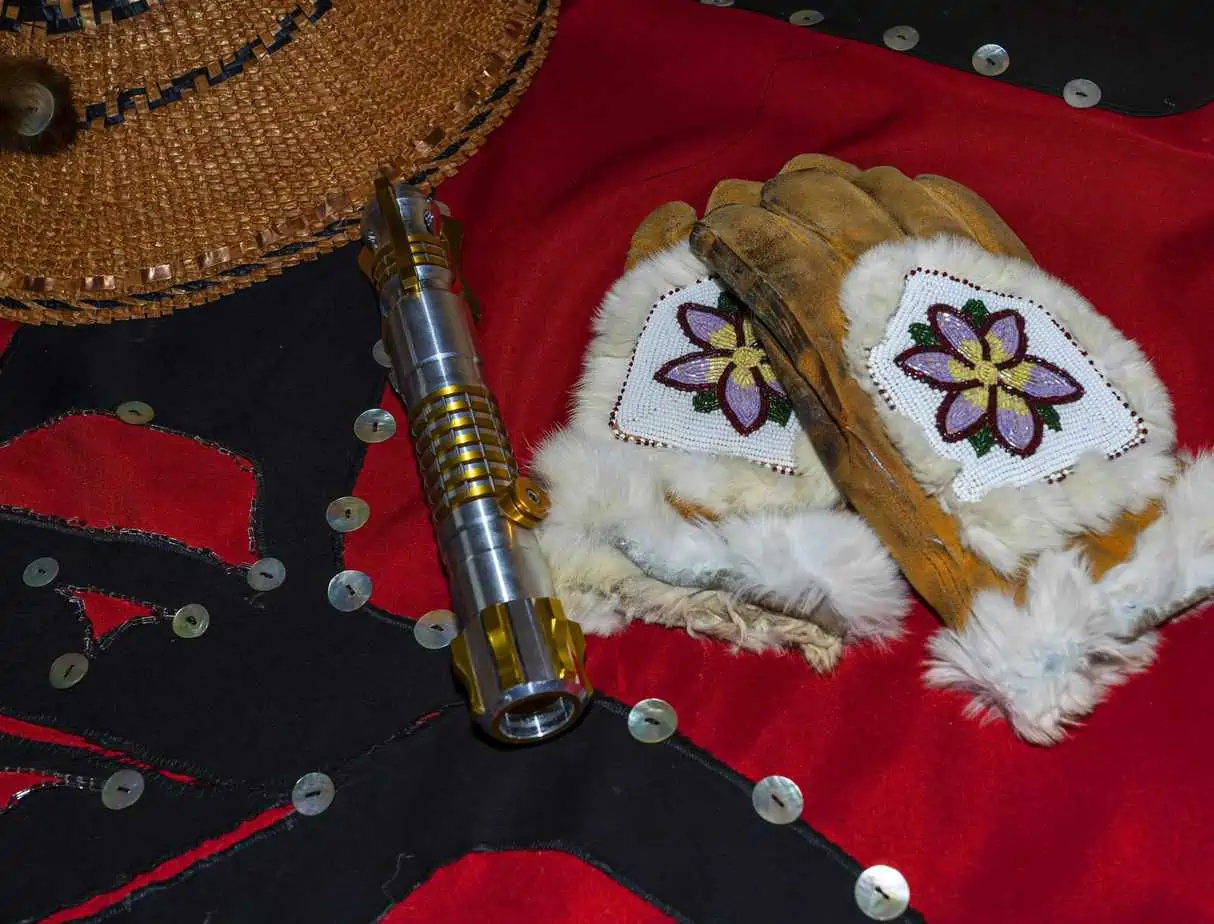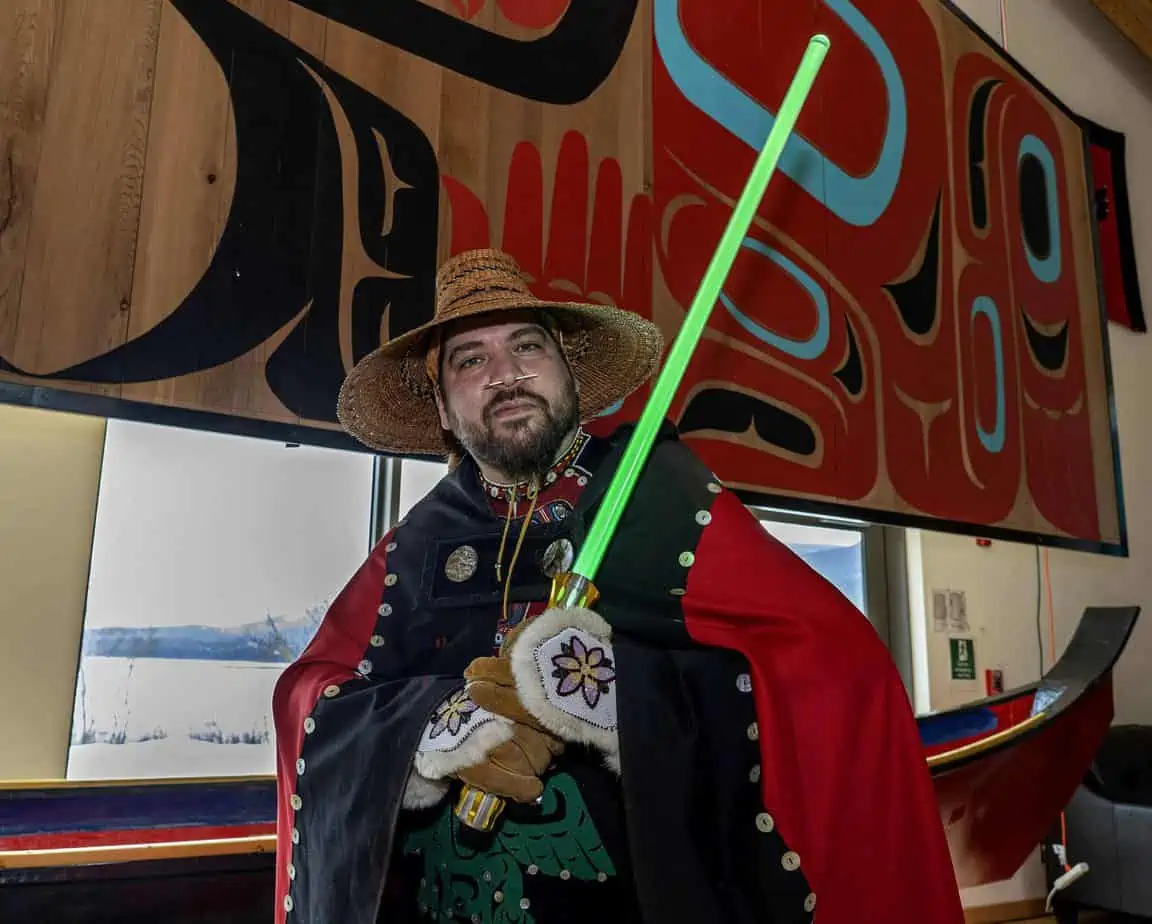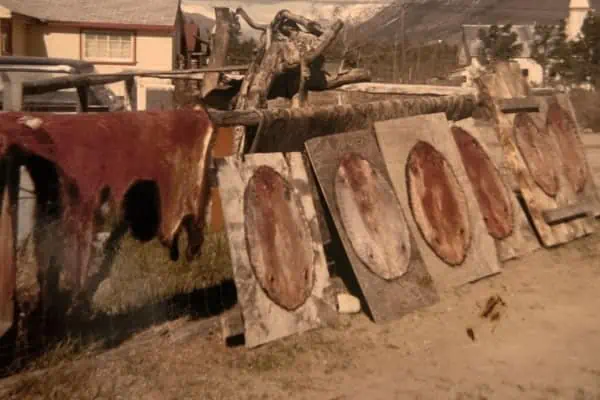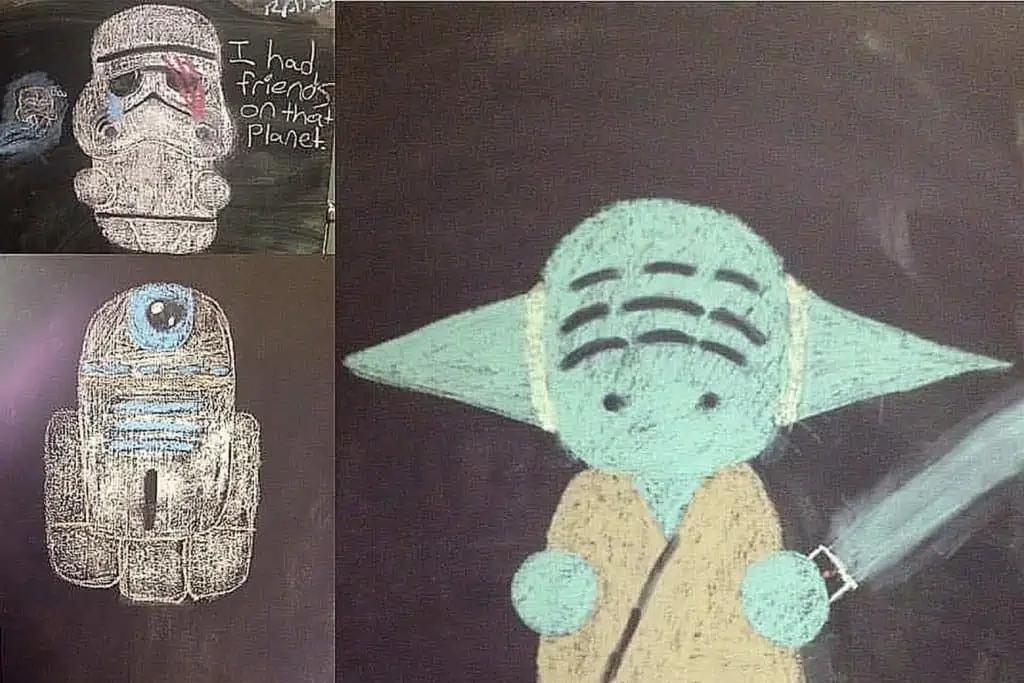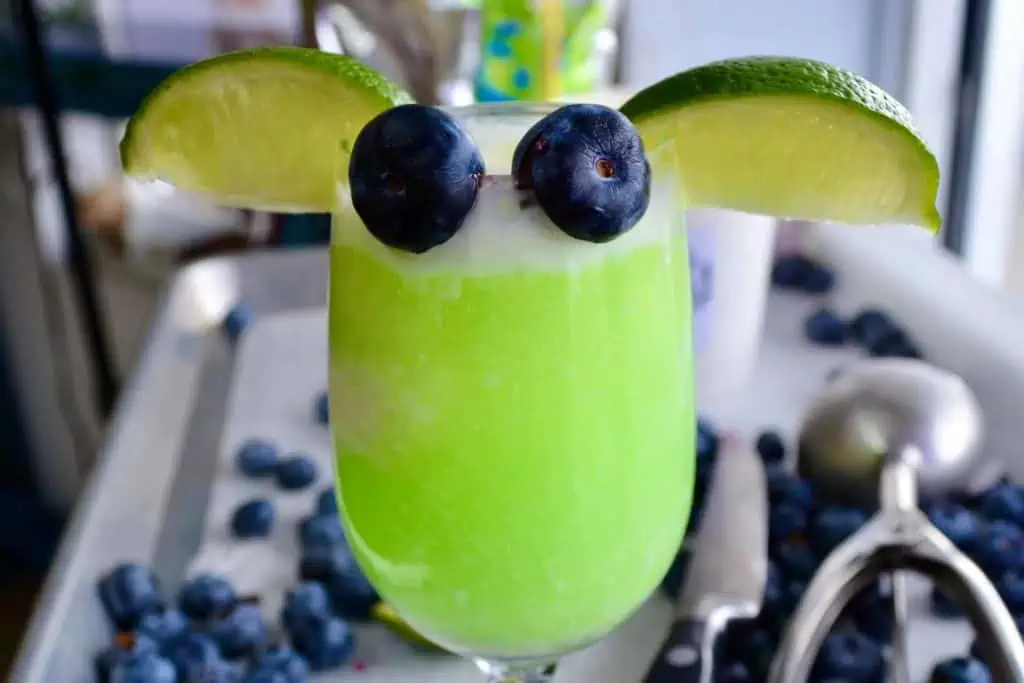Sitting in the afternoon light, amongst a steady flow of people setting up tables and chairs in Haa Shagóon Hídi (Our Ancestors House), in Carcross—a new facility built with towering timbers, grand windows and adorned with traditional Carcross/Tagish First Nation artwork—I speak with a quiet, thoughtful 30-something man dressed in full Daklaweidi (Killer Whale) regalia. His name is Gary Sidney Johnson, and he is a Jedi.
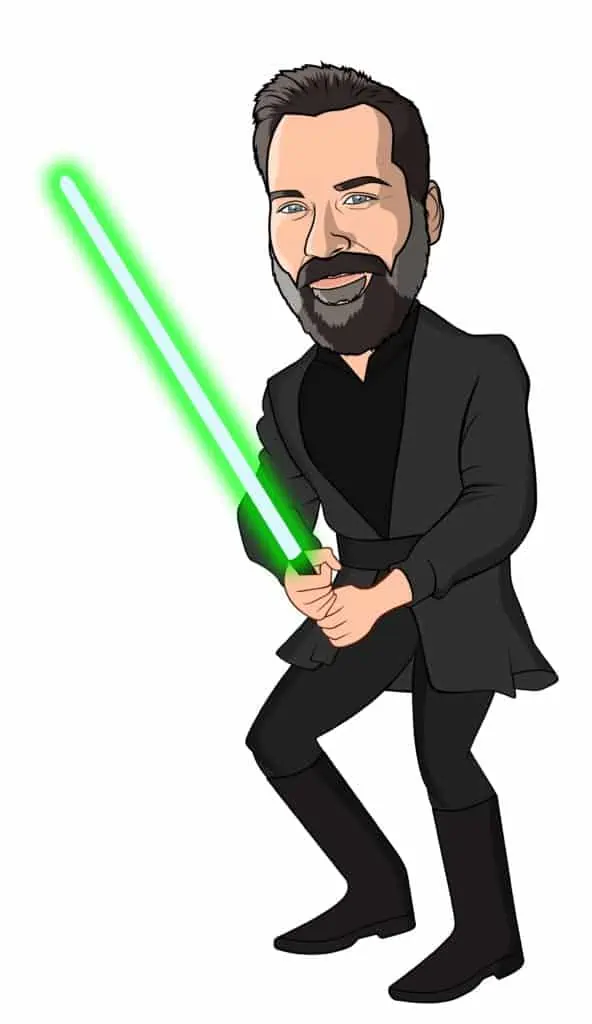
In addition to that, he is also Tagish, Tlingit, Cree, Swedish and French. Johnson also describes himself as a “Cultural Consultant,” for the Learning Centre. There he teaches traditional music, dance, drumming (and drum-making) and language (Tlingit and some Tagish).
“Whenever anything needs to be done here, in this hall or this centre, I am usually the person to call,” Johnson said. “Or I can point you in the direction of someone to call.”
When I asked him if he minds having all that responsibility heaped upon him, he replied with a smile and said, “No, actually. It keeps me humble.” Johnson said that before the pandemic began he was someone who wouldn’t say no to people, always taking on more and more and felt he was being “worn thin” and had to put up some boundaries for himself. But in the two-and-a-half years since the pandemic began, Johnson began to miss the public interaction, speaking and sharing his knowledge and teaching.
“I didn’t realize that what I have is a gift, and I took my gifts for granted.”
His understanding and appreciation for storytelling and passing on knowledge is attributed to his ancestors, in the form of his great-great-grandmother Angela Sidney and his great-grandfather Pete Sidney, and their ability to pass on stories to the next generation.
“They’re like my blue Jedi ghosts, he said. “If you retain the power to do everything right, you can become a spiritual guide.” He added, “I feel like they are still guiding me from the grave.” (A nod to the movie franchise’s Jedi masters, who continued to guide and instruct Jedi and padawans, even in death.)
Johnson said the plan, going forward, is to build up as much information as possible so he can continue to share knowledge, even after he has passed on.
“So the main goal, for me, is to attain as much teachings as I can so that one day, when it’s my time to go, I can be that ‘blue ghost’ that can still communicate.”
Listening to Johnson, it’s not hard to see how this ties directly into both the path of the Jedi and one who is born into Indigenous culture where the student is always learning and then can become the master and train the next generation.
“I want to one day have so much knowledge that I know I’m going to be safe when I die, because I will still be able to teach.”
Johnson said it was around the time he returned to the Yukon, when he was 25, that he started to look more closely at his own cultural history. When he was growing up, he identified more with his European roots and saw only the negative aspects of his Indigenous culture, as pointed out by others. But thankfully, he was able to explore his First Nation roots and soon realized how important it all was, he said.
“Why am I ignoring this beautiful thing?” Johnson added. “The more and more I learned, the more I saw the equivalent things you can see in Star Wars.”
He was raised as a Christian first, then later in the Baha’i Faith, and saw many correlations between religion and the ways of the Jedi. But it wasn’t until he began exploring the teachings of his ancestors that he really began to put his cultural history and the ways of The Force together.
“I still like having the knowledge of the [Baha’i] Faith and Christianity that I have. It kinda gives me a bit of a backstory or something, to build off of, but it wasn’t until I started seeing the cultural stuff, where I’m like, we are Jedis!” he says with a smile and adding, “You look at an Elder and that’s a Jedi council member, you know?”
When it comes to his personal teaching method, Johnson looks to a style he calls “C-3P0-esque” where he channels the famous protocol droid whose role was to assist in etiquette, customs and translation, to the benefit of the other characters in the film franchise. Like C-3P0 (who claimed to be able to communicate in over six-million different ways), Johnson uses animated movements and vocalization in his storytelling. To help him prepare or practise specific language, he will often mimic the voice of Yoda—the wisest of the Jedi—to help him work through words and pronunciations. He uses these tools to help him teach others, Johnson said.
As for getting his first taste of the world of Star Wars, Johnson credits his uncle, Darrell Johnson, who he said was actually made to share his Star Wars toys with a young Gary (by their grandparents and parents), when they played together as children.
“Sadly, I broke a lot of his toys that would be worth lots now,” he said with a chuckle. But those memories of playing, with that collection of toys, engrained themselves into Johnson’s mind. “I swear to God I cannot remember a time without Star Wars, because of my uncle.”
His uncle also helped fuel Johnson’s passion for the movie scores of Star Wars (created by John Williams). So today, Johnson asks what better way to help children learn, during songwriting workshops, than to incorporate Star Wars music into traditional drum songs? He even does an indigenized version of “The Imperial March.”
In a more-modern setting, Johnson has also begun to see the world of Star Wars as not just action and adventure and dynamics between student and master, or even good versus evil. He also sees it as a love story. When he would tell stories to people, many of them would say they thought he was a romantic, he said. “And then I realized the stories I most cling to, have a really strong message of love.”
He credits this, in part, to his wife Felishia, who is 10 years his junior and did not have any real connection to the Star Wars universe. So the plan was to share each other’s film and TV history, to get a better sense of what the other liked.
“My wife did not know Star Wars,” Johnson said. “So we had to do a trade-off. I had to watch all of the seasons of One Tree Hill and Hannah Montanna!” he said with a laugh. “In exchange, she had to watch every Star Wars [film].
The verdict?
“She loved it,” he said, adding that she got turned on to it, right away, and [she] said, “‘Oh my God, this is the best love story ever!’”
That caught Johnson by surprise. “I was like, what? Star Wars ain’t a love story!” But since that day, all he can see is how Star Wars is a love story, Johnson said.
This can be seen in the overtly affectionate relationship between Han and Leia, but also more subtly in the battle for parental love and acceptance between Luke and Darth Vader, or a demonstration of familial love between clan members like the Ewoks.
That love also transitions to the land. Johnson compares The Force to the way Indigenous cultures have always treated the environment in which they live. From the Star Wars standpoint, Johnson talked about a Jedi’s power in relation to The Force and how, originally, it was about how an individual experiences all that is around him or her, allowing them to draw on its power. In later films, it became more about Midi-chlorians inside a Jedi (intelligent microscopic life forms that live symbiotically inside the cells of all living things) that dictate the strength of their relationship with The Force.
“The way Obi-Wan describes it, in A New Hope, is the best way because that’s the Indigenous way of thinking. Everything surrounds us, is a part of us.”
Johnson points out that Jedi are protectors of peace and are not soldiers. Another comparison he sees with his cultural history.
“That’s what Indigenous people really are. If you think about it, anytime we have issues or protests, it’s for the land. It’s never for personal reasons. It’s never to benefit us [individually]. It’s to keep the land safe. We are land guardians. We are [the] Jedis of the land, is what I think we are.”
The land also has the potential to help with healing, Johnson said. In today’s world, that is harder and harder because there are many vices that are available to people that can be destructive and turn them away from making that connection to the natural environment. He touches on alcohol and drug abuse, as major factors, but also video games, TV and movies, which are all examples of escapism that can skew the perception of reality, as he experienced as a younger man who went through his own “party phase.”
Johnson said, in many ways this helps him appreciate the story of DarthVader/Anakin Skywalker, and he sees how that same story plays out over and over in society—both for Indigenous and non-Indigenous peoples. Anakin wanted to be a Jedi so badly that he ended up losing his way and, after straying from the path of the Jedi, eventually became a Sith (the traditional opposite of the Jedi).
“So many of us are ‘Anakin.’ Anakin Skywalker is us. We are always battling those inner demons, whether it be with religion, whether it be on social media, whether it be peer pressure or following peers.”
Johnson said it’s much more difficult to follow the Jedi way.
“To be a Jedi is to do what’s right and stand up for those in need. Not many people want to be a Jedi, so to speak. It’s so easy to be a Sith.”
Johnson said First Nations have faced these issues for a long time, but there is always hope for things to improve. He added he’d like to see more Indigenous Peoples get back in touch with the land, in order to better heal.
He compares that with the cycle of Anakin Skywalker who, after falling from the path, continues to make mistakes but has a chance for redemption and to return to where he began, with the help of his son Luke. Johnson said it’s been a difficult journey for Indigenous Peoples, too. The path has not always been clear.
“We’re so hurt,” he said about intergenerational trauma. “And it’s hard to sometimes find people in your family—those ‘bright lights’ to guide us—because they’re broken as well.”
Johnson said he feels like we have all been on that journey, like Anakin, adding that some people don’t find themselves until they are much older (though a few may be lucky enough to find themselves when they are younger). But so much is lost, for so many people at such a young age, and not many can find their own identity.
“A lot of children don’t know their identity. Don’t know their language. Don’t know their culture.”
But he harkens back to his point about healing from the land and the ways of the Jedi. Johnson said the biggest way for people to heal is through traditional teachings and self-discovery.
Johnson said he had his doubts about his role as a leader, when he was younger, but has since come to accept and welcome the role. He points out that it’s like that transition from Sith to Jedi.
“It’s like I took off that Darth Vader mask.”
Johnson said that combining Jedi with cultural learning has taken him to many places, both physically and mentally.
“It’s taken me into a new, ideal way of thinking.”
It has helped him forget about taking the easy way and take the time to learn and grow and reach for your goals.
Going forward, he would like to see more and more Indigenous Peoples go after cultural learning and celebrate it personally in the arts, storytelling, in dance, and even in the world of TV and film. He added, if people realize, they can be masters of their own career.
“Everybody always needs a story to tell.”

